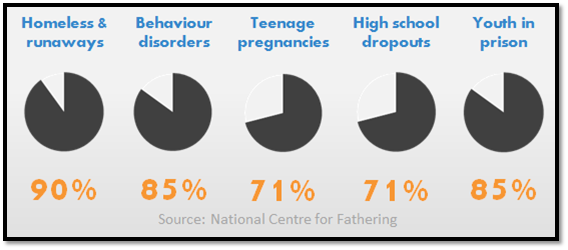The growing epidemic of fatherless families has taken a grave toll on children, both young and old, in the form of emotional, social, spiritual, academic, physical, criminal, and suicidal issues later on in life.
Statistics
- 63% of youth suicides are from fatherless homes (US Dept. Of Health/Census) – 5 times the average.
- 90% of all homeless and runaway children are from fatherless homes – 32 times the average.
- 85% of all children who show behavior disorders come from fatherless homes – 20 times the average. (Center for Disease Control)
- 80% of rapists with anger problems come from fatherless homes –14 times the average. (Justice & Behavior, Vol 14, p. 403-26)
- 71% of all high school dropouts come from fatherless homes – 9 times the average. (National Principals Association Report)
Father Factor in Education – Fatherless children are twice as likely to drop out of school.
- Children with Fathers who are involved are 40% less likely to repeat a grade in school.
- Children with Fathers who are involved are 70% less likely to drop out of school.
- Children with Fathers who are involved are more likely to get A’s in school.
- Children with Fathers who are involved are more likely to enjoy school and engage in extracurricular activities.
- 75% of all adolescent patients in chemical abuse centers come from fatherless homes – 10 times the average.
Father Factor in Drug and Alcohol Abuse – Researchers at Columbia University found that children living in two-parent household with a poor relationship with their father are 68% more likely to smoke, drink, or use drugs compared to all teens in two-parent households. Teens in single mother households are at a 30% higher risk than those in two-parent households.
- 70% of youths in state-operated institutions come from fatherless homes – 9 times the average. (U.S. Dept. of Justice, Sept. 1988)
- 85% of all youths in prison come from fatherless homes – 20 times the average. (Fulton Co. Georgia, Texas Dept. of Correction)
Father Factor in Incarceration – Even after controlling for income, youths in father-absent households still had significantly higher odds of incarceration than those in mother-father families. Youths who never had a father in the household experienced the highest odds. A 2002 Department of Justice survey of 7,000 inmates revealed that 39% of jail inmates lived in mother-only households. Approximately forty-six percent of jail inmates in 2002 had a previously incarcerated family member. One-fifth experienced a father in prison or jail.
Father Factor in Crime – A study of 109 juvenile offenders indicated that family structure significantly predicts delinquency. Adolescents, particularly boys, in single-parent families were at higher risk of status, property and person delinquencies. Moreover, students attending schools with a high proportion of children of single parents are also at risk. A study of 13,986 women in prison showed that more than half grew up without their father. Forty-two percent grew up in a single-mother household and sixteen percent lived with neither parent
Father Factor in Child Abuse – Compared to living with both parents, living in a single-parent home doubles the risk that a child will suffer physical, emotional, or educational neglect. The overall rate of child abuse and neglect in single-parent households is 27.3 children per 1,000, whereas the rate of overall maltreatment in two-parent households is 15.5 per 1,000.
Daughters of single parents without a Father involved are 53% more likely to marry as teenagers, 711% more likely to have children as teenagers, 164% more likely to have a pre-marital birth and 92% more likely to get divorced themselves.
Adolescent girls raised in a 2 parent home with involved Fathers are significantly less likely to be sexually active than girls raised without involved Fathers.
- 43% of US children live without their father [US Department of Census]
- 90% of homeless and runaway children are from fatherless homes. [US D.H.H.S., Bureau of the Census]
- 80% of rapists motivated with displaced anger come from fatherless homes. [Criminal Justice & Behaviour, Vol 14, pp. 403-26, 1978]
- 71% of pregnant teenagers lack a father. [U.S. Department of Health and Human Services press release, Friday, March 26, 1999]
- 63% of youth suicides are from fatherless homes. [US D.H.H.S., Bureau of the Census]
- 85% of children who exhibit behavioral disorders come from fatherless homes. [Center for Disease Control]
- 90% of adolescent repeat arsonists live with only their mother. [Wray Herbert, “Dousing the Kindlers,” Psychology Today, January, 1985, p. 28]
- 71% of high school dropouts come from fatherless homes. [National Principals Association Report on the State of High Schools]
- 75% of adolescent patients in chemical abuse centers come from fatherless homes. [Rainbows f for all God’s Children]
- 70% of juveniles in state operated institutions have no father. [US Department of Justice, Special Report, Sept. 1988]
- 85% of youths in prisons grew up in a fatherless home. [Fulton County Georgia jail populations, Texas Department of Corrections, 1992]
- Fatherless boys and girls are: twice as likely to drop out of high school; twice as likely to end up in jail; four times more likely to need help for emotional or behavioral problems. [US D.H.H.S. news release, March 26, 1999]
Census Fatherhood Statistics
- 64.3 million: Estimated number of fathers across the nation
- 26.5 million: Number of fathers who are part of married-couple families with their own children under the age of 18.
Among these fathers –- 22 percent are raising three or more of their own children under 18 years old (among married-couple family households only).
- 2 percent live in the home of a relative or a non-relative.
- 2.5 million: Number of single fathers, up from 400,000 in 1970. Currently, among single parents living with their children, 18 percent are men.
Among these fathers –- 8 percent are raising three or more of their own children under 18 years old.
- 42 percent are divorced, 38 percent have never married, 16 percent are separated and 4 percent are widowed. (The percentages of those divorced and never married are not significantly different from one another.)
- 16 percent live in the home of a relative or a non-relative.
- 27 percent have an annual family income of $50,000 or more.
- 85 percent: Among the 30.2 million fathers living with children younger than 18, the percentage who lived with their biological children only.
- 11 percent lived with step-children
- 4 percent with adopted children
- < 1 percent with foster children
- Children with involved, loving fathers are significantly more likely to do well in school, have healthy self-esteem, exhibit empathy and pro-social behavior, and avoid high-risk behaviors such as drug use, truancy, and criminal activity compared to children who have uninvolved fathers.
- Studies on parent-child relationships and child wellbeing show that father love is an important factor in predicting the social, emotional, and cognitive development and functioning of children and young adults.
- 24 million children (34 percent) live absent their biological father.
- Nearly 20 million children (27 percent) live in single-parent homes.
- 43 percent of first marriages dissolve within fifteen years; about 60 percent of divorcing couples have children; and approximately one million children each year experience the divorce of their parents.
- Fathers who live with their children are more likely to have a close, enduring relationship with their children than those who do not.
- Compared to children born within marriage, children born to cohabiting parents are three times as likely to experience father absence, and children born to unmarried, non-cohabiting parents are four times as likely to live in a father-absent home.
- About 40 percent of children in father-absent homes have not seen their father at all during the past year; 26 percent of absent fathers live in a different state than their children; and 50 percent of children living absent their father have never set foot in their father’s home.
- Children who live absent their biological fathers are, on average, at least two to three times more likely to be poor, to use drugs, to experience educational, health, emotional and behavioral problems, to be victims of child abuse, and to engage in criminal behavior than their peers who live with their married, biological (or adoptive) parents.
- From 1995 to 2000, the proportion of children living in single-parent homes slightly declined, while the proportion of children living with two married parents remained stable.
Source:https://thefatherlessgeneration.wordpress.com/statistics/






